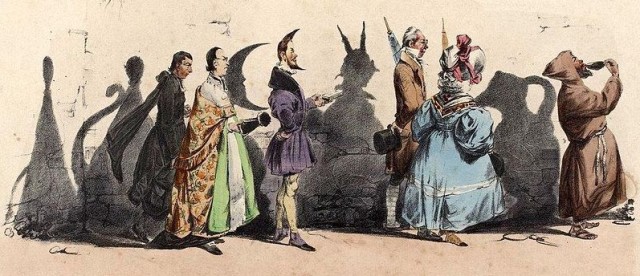These short thumbnails can provide the foundations for characters or adventure seeds.
An amber cat who is searching for the person who stole his whiskers.
An assassin who causes her victim to lose all memory of the person who hired her.
A sage who travels endlessly, recording the earliest memory of everyone he meets.
A ranger trying to find a mate for the last oakhedge sparrow.
A satyr who has fallen in love with the wind.
A prince made of flowers who travels with his entourage to avoid cold weather.
A young man who serves as a groom at an inn near a major road where he hopes to find his father, who was turned into a horse.
A scribe who secretly teaches the mice in the palace to read.
An itinerant fiddle player who can make water dance with her music.
An old woman who claims to be the god of lost and forgotten things.
A gnome merchant who has lost his shadow.
A sage who journeys from place to place trying to map moonlight.
A god of war who wanders the earth planting trees in honor of people killed in his name.
A sailor who woke up in port one morning to see the sails of his ship disappearing over the inland horizon.
A royal librarian who can only remember things she has read.
Friday, March 16, 2018
Thursday, March 15, 2018
Other Skylines
Other Skylines is a rules-light roleplaying game in which the player's roll determines who narrates the outcome of an action.
The Keep on the Borderlands provided the roots of the game. When my best friend and I first started playing RPGs we took turns GMing, swapping off room-by-room and randomly rolling dice because we thought they were cool rather than because we were following any sort of rules. I wanted to try to return to the same loose style of play.
Silas Marques de Lima has translated the game into Portuguese. The illustration by Alba Porta comes from the Spanish translation of an earlier version of the game by Miguel Angel.
The Keep on the Borderlands provided the roots of the game. When my best friend and I first started playing RPGs we took turns GMing, swapping off room-by-room and randomly rolling dice because we thought they were cool rather than because we were following any sort of rules. I wanted to try to return to the same loose style of play.
Silas Marques de Lima has translated the game into Portuguese. The illustration by Alba Porta comes from the Spanish translation of an earlier version of the game by Miguel Angel.
Neon Nights
 |
| Stefano Brivio |
Saturday Knights
Saturday Knights celebrates strange and wonderful overnight game benders. Three
players take on the roles of a teen GM and two friends, and they
struggle through the night to play a game as troubles and distractions
threaten to derail their game.
The game grew out of happy memories of starting games early on Saturday afternoon and not stopping until we were too sleep deprived to focus on Sunday morning, and of wandering the streets with dice in our pockets telling stories and playing games as we browsed convenience stores and watched our small hometown’s lone street cleaner make its rounds.
The game grew out of happy memories of starting games early on Saturday afternoon and not stopping until we were too sleep deprived to focus on Sunday morning, and of wandering the streets with dice in our pockets telling stories and playing games as we browsed convenience stores and watched our small hometown’s lone street cleaner make its rounds.
Red Rock
Red Rock is a post-apocalyptic roleplaying game focusing on a handful of
survivors who have been drawn to an old industrial town. The refugees
have no idea what has happened to the world–or even how long ago the
cataclysm occurred–and struggle with fleeting glimpses of their past
lives as they work to build a new community.
The setting for Red Rock is based on Cass, West Virginia, a former logging town that is now home to a scenic railway. I worked as an interpreter at a museum in Cass one summer. The town was bustling each day but was almost silent at night except for the sound of the Greenbrier River.
Red Rock is also available in Portuguese, thanks to the awesome Silas Marques de Lima.
The setting for Red Rock is based on Cass, West Virginia, a former logging town that is now home to a scenic railway. I worked as an interpreter at a museum in Cass one summer. The town was bustling each day but was almost silent at night except for the sound of the Greenbrier River.
Red Rock is also available in Portuguese, thanks to the awesome Silas Marques de Lima.
The House of Unusual Size
The House of Unusual Size finds the characters trapped in a strange mansion with an infinite
number of shifting rooms. The role of GM moves from player-to-player as
the characters struggle to regain their identities, understand their
connection to the mysterious family that build the home, and escape the
house forever.
Silas Marques de Lima has played a huge role in the game's growth. He has offered invaluable suggestions and has been stalwart in promoting play. Also, being a superfan of all RPGs, he has translated the game into Portuguese.
Silas Marques de Lima has played a huge role in the game's growth. He has offered invaluable suggestions and has been stalwart in promoting play. Also, being a superfan of all RPGs, he has translated the game into Portuguese.
The Wishbook Murders
The Wishbook Murders is game poem of dastardly secrets and mysterious clues for two players. You will need some note cards and a catalog to play.
The players assume the roles of detectives summoned to the scene of a ghastly murder. The game takes place in the year the catalog was published. As play begins the players should each give two facts about the victim.
At the beginning of each round the players open the catalog to a two-page spread. One selects an item from her page to serve as a clue, and asks the other detective to examine it for details by saying something like, "Say, lieutenant, what do you make of this paper cutter?"
The second player describes the item and its potential connection to the crime in lurid and overwrought detail. This is a chance to flesh out the characters and background in the story. For example, "Egads! Why is there a clump of dog hair stuck to the blade? Also, didn't the nanny say her mistress had asked her to start working on birthday invitations even though the party is eleven months away, and that she heard someone whispering in Flemish as she searched the attic for craft supplies?"
After jotting down a few notes about the item on an index card the second player picks an item from her page of the catalog and asks the first player to describe it. After noting the clue players turn to a new two-page spread and begin another round.
Shuffle the note cards after five rounds of investigation. Draw two from the stack of ten to reveal the most important clues in the case. The detectives then craft a treacherous and ghastly solution to the crime centered on these clues. If both of the clues were narrated by the same player, the other player should take the lead in solving the mystery.
The players assume the roles of detectives summoned to the scene of a ghastly murder. The game takes place in the year the catalog was published. As play begins the players should each give two facts about the victim.
At the beginning of each round the players open the catalog to a two-page spread. One selects an item from her page to serve as a clue, and asks the other detective to examine it for details by saying something like, "Say, lieutenant, what do you make of this paper cutter?"
The second player describes the item and its potential connection to the crime in lurid and overwrought detail. This is a chance to flesh out the characters and background in the story. For example, "Egads! Why is there a clump of dog hair stuck to the blade? Also, didn't the nanny say her mistress had asked her to start working on birthday invitations even though the party is eleven months away, and that she heard someone whispering in Flemish as she searched the attic for craft supplies?"
After jotting down a few notes about the item on an index card the second player picks an item from her page of the catalog and asks the first player to describe it. After noting the clue players turn to a new two-page spread and begin another round.
Shuffle the note cards after five rounds of investigation. Draw two from the stack of ten to reveal the most important clues in the case. The detectives then craft a treacherous and ghastly solution to the crime centered on these clues. If both of the clues were narrated by the same player, the other player should take the lead in solving the mystery.
The Dream of the Questing Beast
The Questing Beast is a creature of dreams and prophecies. It appears like a half-remembered song or a dim childhood memory, haunting and inspiring the person chosen to seek it as he or she makes her way through life. Some reject the call and try to turn away from destiny; others struggle to keep it in focus despite being battered by the storms of life. Both face the same sense of longing and mysterious opportunity.
The Dream of the Questing Beast is a story game for three players inspired by the Arthurian legend of Pellinore. The players will trace the life of someone chosen to seek the Beast, describing the character’s encounters with the creature during different phases of life and the ways she tries to understand their strange connection. The group needs to make a few decisions before beginning the game. The story can cover several decades, so players will need to decide when the narrator was born. Each player should also describe one of the Beast’s traits, such as the way fireflies dance above its head when it dreams or how it sings to itself while eating.
You will need a deck of cards to play. Draw to determine who will narrate the first three turns, moving from high to low. The first vignette occurs when the character is somewhere between seven and twelve years old. The other two players contribute elements to the tale. Before the scene begins the player to the narrator’s left names the character’s greatest strength during this phase of life, while the player to the right describes the greatest challenge facing the character during the same period. The scene itself can be a direct encounter with the Beast or a fleeting glimpse, or it could focus on how the character tries to explore her connection to the legend. Each scene should last about five to ten minutes.
When the first narrator has finished describing a vignette the next player lets the group know how many years have passed before the beginning of the second scene. The other players name the character’s strength and the challenge she faces, and the next narrator resumes the tale.
After the third scene, the players draw cards to determine the turn order for the remaining three scenes. The roles of the two non-narrators switch during the final scenes: the player to the narrator’s left names a challenge and the player to the right names a strength. Following the sixth and final scene, the players draw again. The one with the highest card narrates an epilogue. Does she find some sort of peace in her endless search for the phantom creature? Does she give up the quest and live the last years of her life in bitterness? Does she find someone to assume her mantle?
The Dream of the Questing Beast is a story game for three players inspired by the Arthurian legend of Pellinore. The players will trace the life of someone chosen to seek the Beast, describing the character’s encounters with the creature during different phases of life and the ways she tries to understand their strange connection. The group needs to make a few decisions before beginning the game. The story can cover several decades, so players will need to decide when the narrator was born. Each player should also describe one of the Beast’s traits, such as the way fireflies dance above its head when it dreams or how it sings to itself while eating.
You will need a deck of cards to play. Draw to determine who will narrate the first three turns, moving from high to low. The first vignette occurs when the character is somewhere between seven and twelve years old. The other two players contribute elements to the tale. Before the scene begins the player to the narrator’s left names the character’s greatest strength during this phase of life, while the player to the right describes the greatest challenge facing the character during the same period. The scene itself can be a direct encounter with the Beast or a fleeting glimpse, or it could focus on how the character tries to explore her connection to the legend. Each scene should last about five to ten minutes.
When the first narrator has finished describing a vignette the next player lets the group know how many years have passed before the beginning of the second scene. The other players name the character’s strength and the challenge she faces, and the next narrator resumes the tale.
After the third scene, the players draw cards to determine the turn order for the remaining three scenes. The roles of the two non-narrators switch during the final scenes: the player to the narrator’s left names a challenge and the player to the right names a strength. Following the sixth and final scene, the players draw again. The one with the highest card narrates an epilogue. Does she find some sort of peace in her endless search for the phantom creature? Does she give up the quest and live the last years of her life in bitterness? Does she find someone to assume her mantle?
Like a First Kiss
A teen sits in a lonely doughnut shop, sipping coffee for the first time as a summer storm lashes the windows. The door opens and someone steps into the too bright shop: an older stranger who looks vaguely familiar, like a forgotten family friend or half-remembered aunt or uncle. The stranger surveys the scene with a wistful glance, pausing in horror and wonder at the sight of the teen huddled over a dingy mug. . . .
Like a First Kiss traces a long conversation between a teenager and an adult who has traveled back in time to visit the small, overlooked places of life--an adult who is an older version of the same teen. You'll need a coffee cup, some slips of paper, and a couple of six-sided dice to play. As you begin, each player takes three slips and briefly notes some detail from the character's life such as a person, a place, or a key event. Folded and tossed in the mug, these form a framework for he conversation between the teen and adult aspects of the character.
On your turn you play the part of the teen and the player to your right assumes the role of the stranger from the future. Draw a slip to find a topic while the person playing the stranger rolls a die. On a five or six the teen hasn't experienced the detail on the card--the stranger accidentally asked about an encounter in the teenager's future. Otherwise, the detail relates to the teen's recent life or childhood.
The two nervously chat, never explicitly stating that the stranger is an older version of the teen. The person playing the teen clutches the mug as the themes and topics from the cards emerge. The conversations can go in any direction, but remember that the two aspects of the character have different experiences and perspectives. Something the teen views as mundane or prosaic might serve as the foundation of one of the adult's most beautiful and meaningful memories, or the adult may have forgotten about a person or place that the teen adores. Listen to the other scenes, reincorporating themes and questions that appeared to give your scene more depth. The other players can ask for more information, or suggest background details (something on the TV above the counter, a snippet of overheard conversation).
The game winds down after everyone has had at least two scenes as the teenager. The storm clears, and the teen and stranger walk into the parking lot, pausing to look stars emerging from behind the clouds. Each player has a final turn to describe one possible experience, thought, or question the teen has on the way home.
Like a First Kiss traces a long conversation between a teenager and an adult who has traveled back in time to visit the small, overlooked places of life--an adult who is an older version of the same teen. You'll need a coffee cup, some slips of paper, and a couple of six-sided dice to play. As you begin, each player takes three slips and briefly notes some detail from the character's life such as a person, a place, or a key event. Folded and tossed in the mug, these form a framework for he conversation between the teen and adult aspects of the character.
On your turn you play the part of the teen and the player to your right assumes the role of the stranger from the future. Draw a slip to find a topic while the person playing the stranger rolls a die. On a five or six the teen hasn't experienced the detail on the card--the stranger accidentally asked about an encounter in the teenager's future. Otherwise, the detail relates to the teen's recent life or childhood.
The two nervously chat, never explicitly stating that the stranger is an older version of the teen. The person playing the teen clutches the mug as the themes and topics from the cards emerge. The conversations can go in any direction, but remember that the two aspects of the character have different experiences and perspectives. Something the teen views as mundane or prosaic might serve as the foundation of one of the adult's most beautiful and meaningful memories, or the adult may have forgotten about a person or place that the teen adores. Listen to the other scenes, reincorporating themes and questions that appeared to give your scene more depth. The other players can ask for more information, or suggest background details (something on the TV above the counter, a snippet of overheard conversation).
The game winds down after everyone has had at least two scenes as the teenager. The storm clears, and the teen and stranger walk into the parking lot, pausing to look stars emerging from behind the clouds. Each player has a final turn to describe one possible experience, thought, or question the teen has on the way home.
The Dream of a Diamond Chair
The Dream of a Diamond Chair is a two-part story game exploring how children imagine place and the poignant loss of space and place experienced by adults. During the first part of the game, players assume the roles of children who are turning their surroundings into lush imaginary landscapes. On your turn, you will briefly introduce an object and setting and describe—in the most epic, Dunsanian, way possible—the central role it plays in your fantasy world. You can play with scale by turning light fixtures into glowing palaces or space stations, and turn the yard glimpsed through a window into an endless trackless wilderness. The other players then take turns asking about other items nearby, fleshing out the real space and giving you prompts for expanding your dreamland.
Terry: "The chair is my grandmother's kitchen is my diamond throne, from whence I watch the sun rise over the alabaster peaks of Geth."
Mark: "And what of the clock above the stove?"
Terry: "It is the clock tower of the royal observatory, chiming the hours until the three moons converge."
After everyone has had a turn as a child the game moves to a later period in each character's life. On your turn you will now describe why you are visiting the setting for the last time. The other players ask questions to help you explore your feelings and how you will remember the space.
Terry: "My senior year in college my parents called to let me know that my grandmother was moving to a nursing home. I'm visiting to help her pack."
Mark: "Do you ask to take anything from the kitchen as a memento?"
Terry: "The chair is my grandmother's kitchen is my diamond throne, from whence I watch the sun rise over the alabaster peaks of Geth."
Mark: "And what of the clock above the stove?"
Terry: "It is the clock tower of the royal observatory, chiming the hours until the three moons converge."
After everyone has had a turn as a child the game moves to a later period in each character's life. On your turn you will now describe why you are visiting the setting for the last time. The other players ask questions to help you explore your feelings and how you will remember the space.
Terry: "My senior year in college my parents called to let me know that my grandmother was moving to a nursing home. I'm visiting to help her pack."
Mark: "Do you ask to take anything from the kitchen as a memento?"
Pilgrimage
Pilgrimage is a story game about a group of passengers on a ship traveling across the universe. The voyagers come from different worlds and have different reasons for making the journey; all will go their separate ways after the craft has landed, but during their shared time of the massive ship come to learn a little about one another.
Each player creates two pictures before the story begins, and passes one to the player to her left and one to the player to her right. These can be doodles or rough sketches, abstract or representational. The two pictures play a role in each character’s origin and destiny.
After the pictures have been swapped each player spends a moment introducing her character. Incorporating one of the pictures she describes traits like the character’s name, a little about her personality and appearance, or something about her background and her home planet.
Each turn one character becomes the focus of the voyage. The other players may each ask one question. These can be general (“Are you running from something?” or "Tell me about an adventure you've had during the trip") or asked in-character (“What secret do we share?”).
After every character has had a turn the players go around the table describing the destinies of their characters. The destiny incorporates the second picture held by the player, and can range from something that happens as soon as the ship lands to an event several years in the future.
Inspirations
The seeds of Pilgrimage first appeared during a car ride discussion with Johanna Haas about ways to work sketching and doodling into a narrative game, and Silas Marques de Lima’s accounts of teaching story games to groups of teens in counseling sessions. Silas has also crafted a wonderful Portuguese version of the game. A couple of games also played key roles in helping the idea take shape, including Colin Fredericks' Beyond the Beyond, Matthijs Holter's Archipelago, and Maracanda's Alienòr.
Each player creates two pictures before the story begins, and passes one to the player to her left and one to the player to her right. These can be doodles or rough sketches, abstract or representational. The two pictures play a role in each character’s origin and destiny.
After the pictures have been swapped each player spends a moment introducing her character. Incorporating one of the pictures she describes traits like the character’s name, a little about her personality and appearance, or something about her background and her home planet.
Each turn one character becomes the focus of the voyage. The other players may each ask one question. These can be general (“Are you running from something?” or "Tell me about an adventure you've had during the trip") or asked in-character (“What secret do we share?”).
After every character has had a turn the players go around the table describing the destinies of their characters. The destiny incorporates the second picture held by the player, and can range from something that happens as soon as the ship lands to an event several years in the future.
Inspirations
The seeds of Pilgrimage first appeared during a car ride discussion with Johanna Haas about ways to work sketching and doodling into a narrative game, and Silas Marques de Lima’s accounts of teaching story games to groups of teens in counseling sessions. Silas has also crafted a wonderful Portuguese version of the game. A couple of games also played key roles in helping the idea take shape, including Colin Fredericks' Beyond the Beyond, Matthijs Holter's Archipelago, and Maracanda's Alienòr.
Pine Grove
 Pine Grove has seen joy, tragedy, and mystery over the course of its long history. It’s a small town with a long past where you’ll find that everyone and everything is connected in some way if you just ask the right questions.
Pine Grove has seen joy, tragedy, and mystery over the course of its long history. It’s a small town with a long past where you’ll find that everyone and everything is connected in some way if you just ask the right questions.Each round you will explore Pine Grove, its residents, and its history. You’ll need a set of double-six dominoes to play. Draw a tile and in a single sentence describe an aspect of the town based on the higher number shown:
One or six: a person
Two or five: a place
Three or four: an event (either contemporary or historical)
The other players follow, each adding a sentence to the narrative that explores new details and connections. If someone draws a bone with doubles, she creates a secret that reveals some hidden truth about what you’ve been describing—something wondrous or unseemly about life in the small town. For example, the players have been describing the mayor of Pine Grove, focusing on his background, scandals of his administration, and his family. Luis pulls the double five and explains that the mayor molts each spring, leaving the fragile old skins in a locked room in the basement of town hall.
The round ends when a secret has been revealed. The players shuffle the tiles and a new player draws a bone to begin another round. The first player in a round should draw again if she pulls a double.
Special thanks to Silas Marques de Lima for his invaluable advice, and for his work translating the game into Portuguese.
(Pine Grove has served as my default setting for horror, mystery, and contemporary fantasy roleplaying games for quite a while, and bears more than a passing resemblance to my hometown. The idea for the game started to take shape when I was puttering around with a set of Rory's Story Cubes and ended up telling people about the time-traveling turtles who lived above the dime store and the pyramid of bees hidden behind the high school).
The Queen of Nexus

Twice a year a carnival passed through my hometown in West Virginia: once in May for the Strawberry Festival and again in the fall as it wended its way to its winter quarters. I was thinking about the carnival and festival last month as my partner and I were discussing Knight Riders, George Romero’s tale of community, loyalty, and idealism, and the train of thought led to The Queen of Nexus. The game also drew inspiration from Nathan Russell’s Freeform Universal System and Maracanda’s Alienor.
The Queen of Nexus PDF
Subscribe to:
Posts (Atom)





_(14766955365).jpg/488px-Tales_of_the_Round_table%3B_based_on_the_tales_in_the_Book_of_romance_(1908)_(14766955365).jpg)


